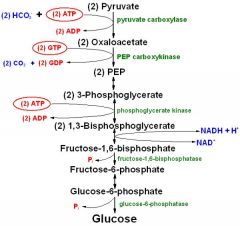![]()
![]()
![]()
Use LEFT and RIGHT arrow keys to navigate between flashcards;
Use UP and DOWN arrow keys to flip the card;
H to show hint;
A reads text to speech;
9 Cards in this Set
- Front
- Back
|
Blank
|
Blank
|
|
|
Indicate where in the cell and in which organs gluconeogenesis occurs
|
Gluconeogenesis takes place primarily in the liver and to a smaller extent, in the kidneys. This process occurs during fasting, starvation, or intense exercise and is highly endergonic. Gluconeogenesis is often associated with ketosis (the formation of KB from FAs during hypoglycemia or when FAs are abundant). The pathway begins in the mitochondria or cytosol depending on the substrate being used, but the most common site is the mitochondria. Muscles have no glucagon receptors and lack the glucose-6-phosphate enzyme.
|
|
|
Discuss the importance of gluconeogenesis including its role in the Cori Cycle
|
Gluconeogenesis is involved in maintaining blood glucose concentrations during periods of fasting. Some tissues are dependent on a constant supply of glucose (brain, RBCs).
|
|
|
List the main substrates for gluconeogenesis, and under what conditions each in important.
|
X
|
|
|
Describe the gluconeogenic pathway starting from pyruvate and highlight the irreversible reactions of gluconeogenesis
|

|
|
|
Explain how carbons formed from other sources (eg. glucogenic amina acids, lactate and glycerol) integrate inot gluconeogenesis
|
Lactate is primarily produces in myocytes and RBCs as well as in any cells that lack mitochondria. Lactate is delivered to the liver via the blood where it is oxidized to pyruvate via LDH 5 (Cori Cycle). During anerobic exercise pyruvate is generated in muscle tissues and NAD+ is regenerated by reduction of pyruvate to lactate. The Cori cycle is instrumental in shifting the metabolic burden from the muscle to the liver where C atoms can be recycled back into glucose synthesis/storage.
Most AAs are glucogenic. Alanine and glutamine are the principle glucogenic AAs derived from muscle proteins; N atoms can be transported into the blood as either glutamine or alanin and eventually are converted into urea by the urea cycle. Hepatic glutaminases free ammonia from glutamine. Alanine undergoes transamination producing pyruvate once again. Glycerol liberated from adipose tissue, in addition to that produced by LPLase, is phosphorylated by hepatic glycerol kinase; LPLase hydrolyzes chylomicron TAC in blood capillaries producing NEFas and glycerol. Glycerol 3-P is then converted into DHAP (an intermediate in to glycotic/gluconeogenic) pathways. Propioncyl CoA is produced from FAs and is converted into succinyl-CoA and is also therefore regarded as being gluconeogenic. |
|
|
Justify why there can be no net production of glucose from acetyl CoA or its progenitors eg. fatty acids and ketone bodies
|
Acetyl CoA (from pyruvate, FAs) is only a two C structure that is lost as CO2 in the TCA cycle. There is no net gain of carbons to facilitate the formation of glucose. Thus while acetyl CoA is not a precursor for gluconeogenesis, OAA is a precursor.
|
|
|
Distinguish the role of glucagon and insulin on gluconeogensis. Explore the role of fructose 2,6 bisphosphate on gluconeogenesis.
|
X
|
|
|
Compare the regulation of glycolysis and gluconeogenesis in liver in the fed and fasted state
|
X
|

